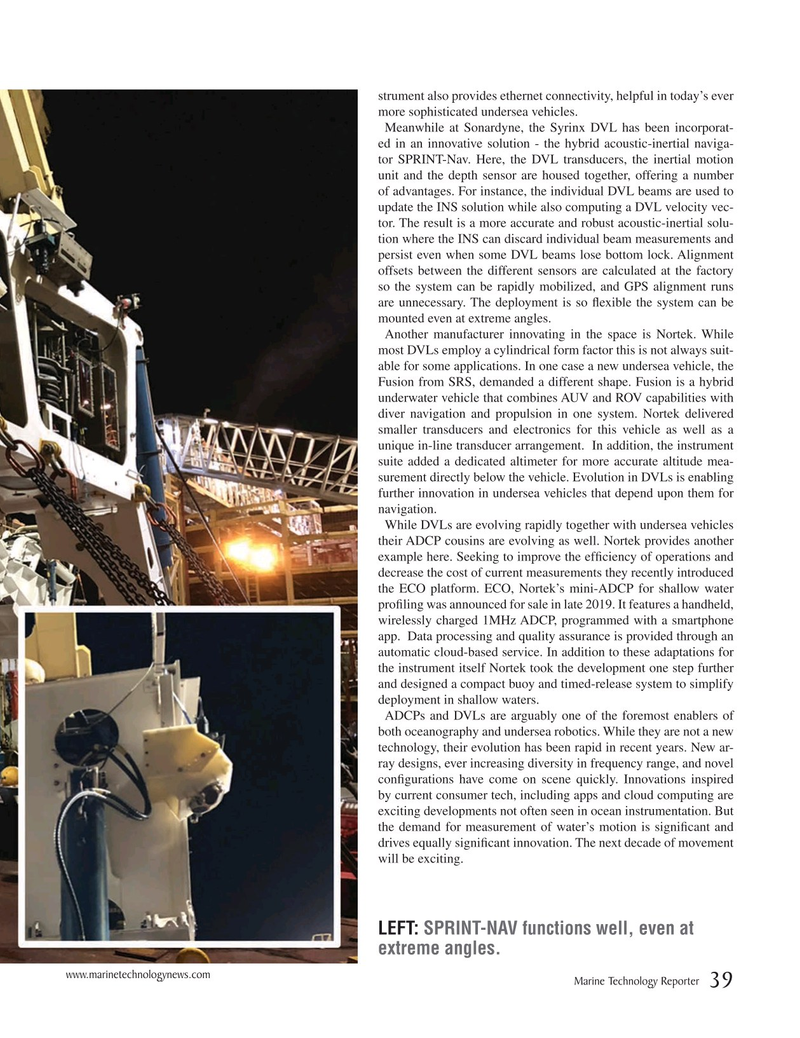
Page 39: of Marine Technology Magazine (November 2019)
MTR White Papers: Subsea Vehicles
Read this page in Pdf, Flash or Html5 edition of November 2019 Marine Technology Magazine
strument also provides ethernet connectivity, helpful in today’s ever more sophisticated undersea vehicles.
Meanwhile at Sonardyne, the Syrinx DVL has been incorporat- ed in an innovative solution - the hybrid acoustic-inertial naviga- tor SPRINT-Nav. Here, the DVL transducers, the inertial motion unit and the depth sensor are housed together, offering a number of advantages. For instance, the individual DVL beams are used to update the INS solution while also computing a DVL velocity vec- tor. The result is a more accurate and robust acoustic-inertial solu- tion where the INS can discard individual beam measurements and persist even when some DVL beams lose bottom lock. Alignment offsets between the different sensors are calculated at the factory so the system can be rapidly mobilized, and GPS alignment runs are unnecessary. The deployment is so ? exible the system can be mounted even at extreme angles.
Another manufacturer innovating in the space is Nortek. While most DVLs employ a cylindrical form factor this is not always suit- able for some applications. In one case a new undersea vehicle, the
Fusion from SRS, demanded a different shape. Fusion is a hybrid underwater vehicle that combines AUV and ROV capabilities with diver navigation and propulsion in one system. Nortek delivered smaller transducers and electronics for this vehicle as well as a unique in-line transducer arrangement. In addition, the instrument suite added a dedicated altimeter for more accurate altitude mea- surement directly below the vehicle. Evolution in DVLs is enabling further innovation in undersea vehicles that depend upon them for navigation.
While DVLs are evolving rapidly together with undersea vehicles their ADCP cousins are evolving as well. Nortek provides another example here. Seeking to improve the ef? ciency of operations and decrease the cost of current measurements they recently introduced the ECO platform. ECO, Nortek’s mini-ADCP for shallow water pro? ling was announced for sale in late 2019. It features a handheld, wirelessly charged 1MHz ADCP, programmed with a smartphone app. Data processing and quality assurance is provided through an automatic cloud-based service. In addition to these adaptations for the instrument itself Nortek took the development one step further and designed a compact buoy and timed-release system to simplify deployment in shallow waters.
ADCPs and DVLs are arguably one of the foremost enablers of both oceanography and undersea robotics. While they are not a new technology, their evolution has been rapid in recent years. New ar- ray designs, ever increasing diversity in frequency range, and novel con? gurations have come on scene quickly. Innovations inspired by current consumer tech, including apps and cloud computing are exciting developments not often seen in ocean instrumentation. But the demand for measurement of water’s motion is signi? cant and drives equally signi? cant innovation. The next decade of movement will be exciting.
LEFT: SPRINT-NAV functions well, even at extreme angles.
www.marinetechnologynews.com
Marine Technology Reporter 39
MTR #9 (34-49).indd 39 12/2/2019 11:23:53 AM

 38
38

 40
40
